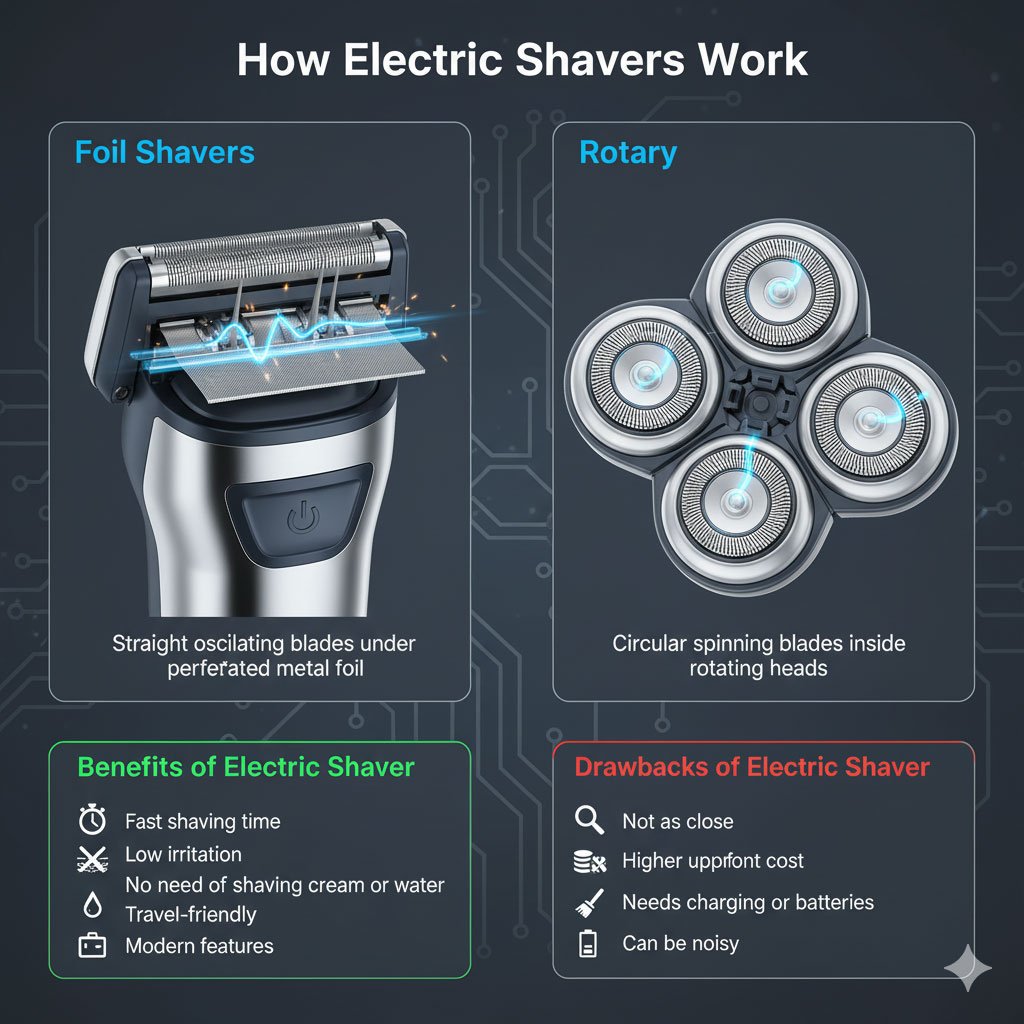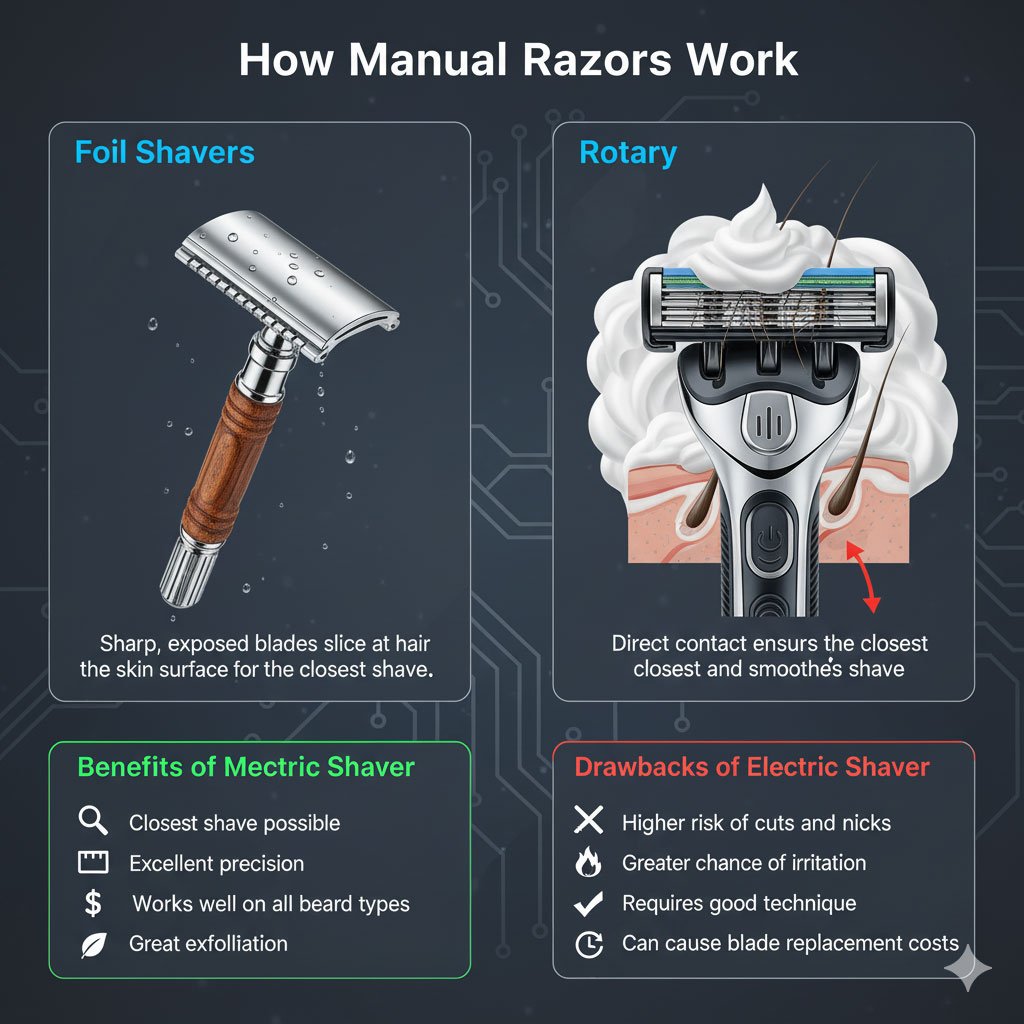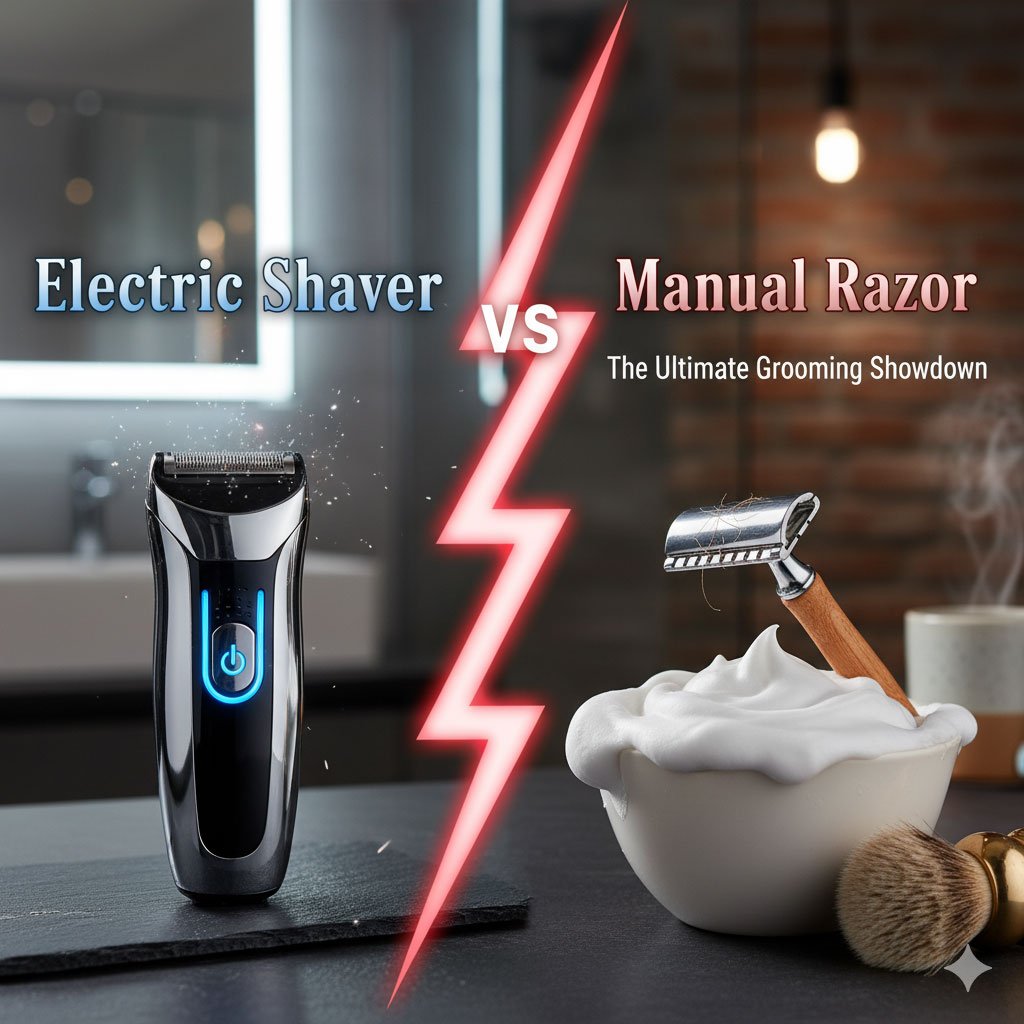When you compare electric shaver vs manual razor, you want more than a quick answer. You want a real understanding of which shaving tool fits your skin, your lifestyle, and your expectations. Shaving may look simple, but the wrong choice can cause irritation, razor bumps, or wasted time each morning. That’s why this guide breaks down every angle—performance, cost, comfort, beard type, convenience, safety, and long-term usability—so you can choose confidently.
This is not general advice. It’s a complete breakdown written directly for you, based on what you value in your daily routine. If you shave often, even small differences matter. A little improvement in comfort or speed can save you minutes and help your skin look better every day.
Table of Contents
Core Difference Between Electric Shaver & Manual Razor
Before choosing, you need to understand the fundamental difference:
- Electric shavers cut hair using fast-moving blades behind a thin metal guard.
- Manual razors use exposed blades that cut hair at skin level.
This single difference shapes everything else—closeness, irritation, safety, time, and cost. So let’s break everything down clearly and simply.
How Electric Shavers Work
Electric shavers use one of two systems:
- Foil shavers – Use straight oscillating blades under a perforated metal foil.
- Rotary shavers – Use circular spinning blades inside rotating heads.
Both are designed to prevent the blade from fully touching your skin. This gives you a comfortable shave with minimal risk of cuts.

Benefits of Electric Shaver
- Fast shaving time — perfect when you need a quick shave.
- Low irritation because the blade doesn’t fully touch your skin.
- Safe and cut-free shaving experience.
- Ideal for sensitive skin due to reduced friction.
- No need for shaving cream or water for dry shaving.
- Convenient for daily shaving and maintaining short stubble.
- Easy to use even for beginners.
- Travel-friendly and can be used anywhere.
- Less mess since no creams or rinsing are required.
- Modern features like self-cleaning systems, wet/dry modes, and quick charging.
Drawbacks of Electric Shaver
- Not as close as a manual razor, especially on thick or coarse hair.
- Higher upfront cost compared to manual razors.
- Requires regular cleaning to maintain performance.
- Needs charging or batteries, which can be inconvenient if it runs out mid-shave.
- Can be noisy, depending on the model.
- Less effective on long or flattened hair, making it best for short stubble.
- Replacement foils and blades add to long-term maintenance cost.
How Manual Razors Work
Manual razors use sharp, exposed blades to slice hair right at the surface of your skin. The direct contact ensures the closest and smoothest shave possible.

Benefits of Manual Razor
- Closest shave possible due to direct blade-to-skin contact.
- Excellent precision, ideal for shaping beards, mustaches, and sideburns.
- Affordable upfront cost — razors and blades are budget-friendly.
- Works well on all beard types, including thick and coarse hair.
- No charging or batteries required; fully manual.
- Great exfoliation, helping remove dead skin cells while shaving.
- Widely available — blades and razors are easy to find anywhere.
- Smooth, long-lasting results, especially for fast-growing facial hair.
Drawbacks of Manual Razor
- Higher risk of cuts and nicks due to exposed blades.
- Greater chance of irritation like razor burn or redness.
- Time-consuming because you need water, shaving cream, and careful strokes.
- Requires good technique to avoid pulling hair or causing bumps.
- Ongoing blade replacement costs can add up over time.
- Can cause ingrown hairs, especially on curly or coarse hair.
- Less convenient for travel because you need creams or gels.
Electric Shaver vs Manual Razor
Feature | Electric Shaver | Manual Razor |
|---|---|---|
Shave Closeness | Moderate | Very close |
Skin Comfort | High | Medium |
Time Required | Very fast | Slower |
Learning Difficulty | Very easy | Easy |
Ideal Skin Type | Sensitive, dry | Normal, oily |
Beard Type Suitability | Thin to medium | All types |
Cost Over Time | Moderate | Moderate to high |
Risk of Cuts | Extremely low | Higher |
Maintenance | Cleaning, charging | Changing blades |
Travel Friendly | Yes | Yes |
Wet Shaving Support | Some models | Yes |
Noise Level | Moderate | Silent |
Which One Is Better for Your Skin Type?
Choosing the right shaving tool becomes much easier when you think about your skin first. Your skin reacts to every pass of the blade, so the wrong match can lead to irritation, bumps, or dryness. Here’s how to pick the perfect fit for your skin type:
Sensitive Skin
If your skin gets red or irritated easily, an electric shaver is your best friend.
It glides over your skin with almost no pressure, and the blade never fully touches your face. That means fewer bumps, fewer flare-ups, and way less discomfort.
Dry Skin
Dry skin already feels tight and delicate. Electric shavers work well because you don’t need water or foam. You shave quickly without stripping your skin’s natural moisture. If you want extra smoothness, choose a wet/dry model and pair it with a gentle gel.
Oily or Combination Skin
If your skin gets shiny or oily, a manual razor might actually feel better.
During shaving, the blade lightly exfoliates your skin and removes buildup from your pores, giving you a fresher, cleaner finish.
Acne-Prone Skin
Electric shavers are usually safer because they don’t drag across the skin or scrape over pimples. You avoid irritation and reduce the risk of accidentally cutting inflamed spots.
Thick or Coarse Beard + Sensitive Skin?
This is a tricky combo. Electric shaver for comfort.
Manual razor for closeness.
You may want both—using an electric for daily shaving and a manual razor only when you want an ultra-close finish.
Which One Saves More Time?
If time matters to you — and it probably does — the winner is easy to spot.
Electric Shaver: The Clear Time-Saver
When you’re rushing in the morning or trying to get out the door fast, an electric shaver works like a shortcut.
You don’t need water.
You don’t need shaving cream.
You don’t even need to prep your skin.
Just turn it on, make a few passes, and you’re done. Most people can finish a clean shave in 2–3 minutes, making it perfect for busy mornings or quick touch-ups.
Manual Razor: Slower but More Detailed
A manual razor takes more time because you need a full shaving setup.
You have to wet your face, apply shaving foam or gel, shave carefully, rinse, and sometimes go over tricky spots twice.
It’s a slower process, but it pays off with that ultra-smooth finish.
So Which One Wins?
If your main goal is speed and convenience, the electric shaver wins without question.
But if you don’t mind spending extra time for a closer, more polished result, the manual razor still has its charm.
Which One Is More Cost-Effective?
When you’re comparing shaving tools, price isn’t just about what you pay today. It’s about what you’ll keep paying over the months and years. Both options have long-term costs, so it helps to look at the full picture.
Electric Shaver: High Upfront, Lower Over Time
An electric shaver usually costs more at the beginning.
But once you have it, your ongoing costs are pretty predictable.
You’ll replace the blades or foils every 6–12 months, and that’s about it. There’s no need for shaving cream, gels, or disposable cartridges. The electricity cost is extremely low — just a few cents per charge.
So yes, the upfront price is higher, but the long-term expenses are manageable.
Manual Razor: Cheap to Start, Costlier Over Time
A manual razor is budget-friendly at first.
The razor handle itself is cheap, and you’ll find countless options in every store.
However, the real cost shows up slowly: replacement cartridges.
Depending on the brand, these can get expensive, especially if you shave often. Add shaving cream, gel, and aftershave, and the costs stack up month after month.
So Which One Is More Cost-Effective?
It depends on your routine:
- If you shave daily and want predictable costs, an electric shaver is usually more economical.
- If you shave occasionally, a manual razor might still be the cheaper choice.
In the long run, both options can end up costing about the same — but the electric shaver spreads the cost more evenly, while the manual razor hits your wallet more often.
Bottom Line
Choosing between an electric shaver vs manual razor depends on what matters most to you. Electric shavers offer speed, comfort, and safety. Manual razors deliver the smoothest shave and better precision. Both tools have strengths. Pick the one that matches your skin type, lifestyle, and grooming expectations for the best results every day.



